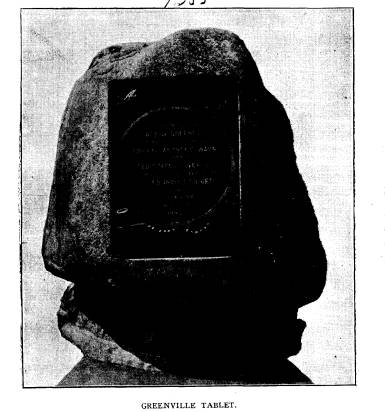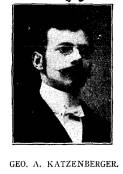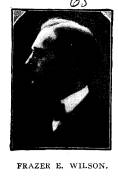Ohio History Journal
|
EDITORIALANA. |
|
|
|
FORT STEPHENSON CELEBRATON. August 2d, 1906, was the ninety-third anniversary of the gallant defense of Fort Stephenson, the site of which is now the center of the attractive and enterprising city of Fremont. The heroic and unparalleled "holding" of the little stockade fort by Major George Croghan on August 2d, 1813, against some two thousand British troops under General Proc- tor and an equal number of Indian braves under Chief Tecumseh is one of the most memorable events not only in Ohio history but in the history of our country. For many years post Colonel Webb. C. Hayes, resident of the historic Hayes homestead, Spiegal Grove, Fremont, has been in search of the remains of the gallant George Croghan. He finally found them in an old buryingplace near Louisville, Ky., whence they were secured and removed to Fremont and on the day in question were re-interred at the base of the monument marking the spot of the old stockade enclosure. Over his grave will be planted a spray of myrtle which was brought from his former burial place. "Fort Stephenson Park" thus has an added interest and has become a sacred spot to which the citizens of Fremont and Ohio can point with pride and say: "On that spot was fought one of the decisive battles of the War of 1812 and within its borders, enthroned with glory, lies the man who said: 'We have decided to defend the Fort, and by Heaven we can.'" The day of the celebration was a beautiful one and thousands of Ohio's citizens gathered at Fremont to witness the elaborate and imposing ceremonies. The Sixth Regiment of the Ohio National Guard was pre- sent and gave fitting military character to the occasion. The nation was represented by Vice-President Fairbanks and the state by Governor Harris and his staff. Addresses were delivered by many distinguished speakers. The Ohio State Archaeological and Historical Society was represented on the program by its secretary. The proceedings will be set forth in detail in the forthcoming January (1907) QUARTERLY of the Society.
UNVEILING GREENVILLE TABLET. Greenville has witnessed many historic gatherings commemorative of the signing of the Greenville Treaty on August 3d, 1795. The formal signing of this treaty by General Anthony Wayne and other (499) |
|
500 Ohio Arch. and Hist. Society Publications.
government officials on the part of the United States and some ninety Indian chiefs and Sachems on behalf of the conquered Indian tribes was one of the most potent episodes in western history. On August 3d, 1895, under the auspices of the Ohio State Archaeological and His- torical Society, a fitting centennial celebration was held at Greenville, in which Governor McKinley, Hon. Samuel F. Hunt, Hon. William J. |
|
|
|
Gilmore and Hon. Samuel H. Doyle, delivered eloquent and inspiring addresses. But not until this last anniversary (August 3, 1906) was any attempt made to erect any memorial perpetuative of the event. Through the patriotic and indefatigable efforts of Mr. George A. Katzen- berger, President of the Historical Society of Greenville, and Mr. Frazer E. Wilson, author of the most complete and authentic account of the "Treaty of Greenville," aided by the members of the Greenville His- |
|
Editorialana. 501
torical Society and other citizens of Greenville, a memento was secured in the shape of a collossal granite boulder upon the face of which was attached an artistic bronze tablet, inscribing the event. The cere- monies attending the unveiling were worthy the occasion. A parade preceded the exercises at the tablet. This was participated in by the members of Company M., 3d Regiment, Ohio Militia, Red Men, repre- senting Little Turtle Tribe, (Greenville); Minnehaha Tribe (Bradford); Mississinawa Tribe (Union City); Big Foot Tribe (New Madison) and Oklawaha Tribe (Ithaca); the G. A. R.; Greenville Historical Society; Treaty City Club and speakers in automobiles. When the procession reached the boulder and tablet on West Main Street, which were covered with the American flag, the band played "Hail Columbia" and "America" was sung by a chorus of voices. Rev. J. P. Alden, pastor of the Reformed church, made the invoca- tion, after which Mr. George A. Katzenberger, President of the Historical Society, presented the treaty memorial to the city in the following speech: Ladies and Gentlemen: Eleven years ago there was held in this city the Centennial of the Treaty of Greenville. One of the speakers, our martyred president, |
|
|
William McKinley, then governor of our state, ended his address as follows: "We can not have too many of these celebrations with their impressive lessons of patriotism and sacrifice. Let us teach our children to revere the past, for by its example and lessons alone can we wisely prepare them for a better and nobler future. The city of Greenville, the people of Ohio, the people of the country, should see to it that at no distant day a great monument shall be erected to celebrate this great event." In a similar vein, Judge Samuel F. Hunt con- cluded his address at the centennial in 1895: "If, too, the victories of peace are not less |
|
renowned than those of war, then the day will surely come when a grateful people, revering their traditions, and conscious of the maxims imperial of their glory, will erect on this historic ground a majestic monument having an outstretched hand, rather than a fixed bayonet with the simple yet immortal inscription, "The Treaty of Greenville." The long desired monument is not yet a reality. The military achievements of Anthony Wayne are consecrated in the history of his country and in the hearts of his countrymen, but no monument marks this site of his greatest achievement. However, we have here among our young men an organization known as the Greenville Historical Society, which has held monthly |
|
502 Ohio Arch. and Hist. Society Publications.
meetings since 1903. One of the objects of the society is the securing of a Wayne memorial and under the readership of Mr. Frazier Wilson, we have labored together to awaken in the public an interest in matters historical. We have succeeded in part and have secured from the citizens funds sufficient to purchase a tablet which will commemorate the treaty which put courage in the heart of the pioneer and gave hope to his brave wife. The members of Little Turtle Tribe of Red Men have co-operated with us to make this event a success, and we also owe grateful acknowl- edgement to the veterans of the Grand Army of the Republic and to |
|
|
the members of Company M, Third Regiment, as well as to the liberality of our business men who assisted financially. The boulder was presented to us by Frank D. Meeker, and placed in position gratuitously by Mr. John Horlacher and sons. It will be unveiled by Sanford Irwin, a de- scendant of Thomas Irwin, who was a soldier in the army of St. Clair, and by Oscar Kerlin, Jr., a descendant of Major George Adams, who commanded Fort Greenville in 1812. May the ruggedness of this granite boulder be a reminder of the virtues of those who fought, bled and died for this territory and may its |
|
power to withstand the elements be exceeded by the ability of our country to withstand all its foes both without and within. And now on behalf of the members of the Greenville Historical Society I present to the public, through you this Memorial Boulder. The unveiling of the tablet followed by Masters Sanford Irwin and Oscar Kerlin, Jr., and a military salute was fired by members of Company M. After a rendition of "Star Spangled Banner" by the band, Hon. T. C. Maher, chief executive of the city, accepted the memorial on behalf of the city in the following speech: Mr. Chairmen, Ladies and Gentlemen: On August 3, 1795, one hundred and eleven years ago, there occurred upon this spot a most momentous event in the history of this country. Here, as every student knows, was signed the Treaty of Greenville, that opened for development and civilization the vast territory that is now known as the Great Mississippi Valley, and from a dense forest it has since been brought by the hand of enterprise and energy of the sons and daughters of America, to be the homes of millions of loyal sons and daughters of liberty loving people. |
Editorialana. 503
My friends, as mayor of the city, and as
a representative of her
citizens, I accept for the city as a
mark to the memory of the heroes,
who, moved by a spirit of patriotism,
made it possible that we might
live in our now pleasant homes. This
unpretentious mark of our love
and gratitude to them will last longer
than the granite shaft that will
some day be erected to their memory by
our citizens.
The Historical Society of our little
city deserves the gratitude of
our hearts for what it has done, and I
hope that in no far distant day
we will be able to have the pleasure of
attending the unveiling of a
mounment built by the city, county,
state and national government to
the memory of the gallant heroes whom
they today honor, to the gallant
soldiers of all other wars in which the
citizens of our county and
state participated.
And now I think it mete and proper that
this monument be again
put into the care and guardianship of
the same hand that created it,
and in behalf of the citizens and
people, I hereby put this mark in the
care of the Historical Society of
Greenville, that their ever watchful
eye may keep it in its present
condition, and preserve it until a more
stately and suitable monument is
erected.
Major Maher was followed by Mr. S. M.
Gorham, Grand Sachem
of Ohio Improved Order of Red Men. His
address was an appropriate
tribute to the crude but simple
character of the Indian, his nobility and
fidelity, his achievements in peace and
was and his debasement and
sufferings at the hands of his
overpowering pale face antogonist. The
historic address was made by E. O.
Randall, Secretary of the Ohio
State Archaeological and Historical
Society. The speaker's theme was
the significance and result of the
contest between the white and the red
man in the Ohio Valley, lasting half a
century, from Pontiac's conspir-
act in 1763 to the termination of
Tecumseh's confederacy in 1813.
Appropriate impromptu remarks were made
by Mrs. Edward Orton, Jr.,
Regent, Columbus Chapter D. A. R.; Mr.
Clement R. Gilmore of Dayton,
son of Judge W. R. Gilmore, who
delivered the address at the Centennial
in 18895; Hon. A. R. Robeson and others.
An interesting incident con-
nected with the program was the fact
that the fifer in the G. A. R.
band, Mr. William Henry Harrison
Reppeto, who had spent four years
(1861-5) in splendid service for the
unity and perpetuity of his country
was a grandson of Alexander McEowen, who
though at that time only
sixteen years of age, saw service in the
ranks of the army of General
Wayne and was present at and witnessed
the sacred ceremonies of the
eventful treaty.
PERRY'S VICTORY CELEBRATION.
September 10, (1906) the Maumee Valley
Historical Association
held its annual observance of the
memorable victory on Lake Erie, 1813,


